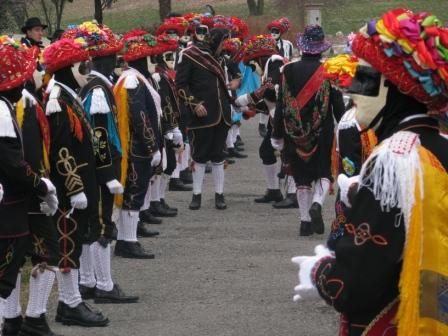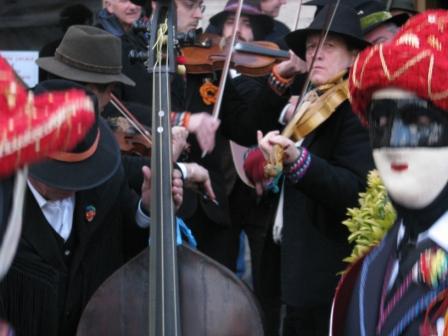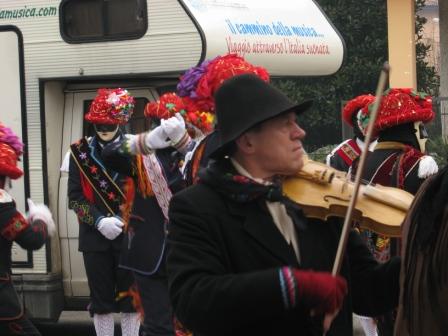It is evening when the camper successfully passes the steep ascents of Trentino mountains to arrive to the north-eastern Alps of Lombardy. I was passing through the bridge that marks the border between the two regions when suddenly suspect people,  covered with coats and black hats, slink everywhere as a sign of fervent excitement. They are the màscher with the traditional clothes ceviöl. I risk they open the camper door throwing me an handful of confetti but fifty years ago it would have been a bucket of dead fish...
covered with coats and black hats, slink everywhere as a sign of fervent excitement. They are the màscher with the traditional clothes ceviöl. I risk they open the camper door throwing me an handful of confetti but fifty years ago it would have been a bucket of dead fish...
I’m in Ponte Caffaro in the province of Brescia (Lombardy). Since ancient times in this valley they celebrate one of the most characteristic carnivals of the Italian Alps, the bagosso carnival. My reference person is called Gigi Bonomelli, virtuous violinist of the "Compagnia dei Sonadùr", the leaders of this carnival. They inform me he is movig around the city playing in bars, so I look for him but everybody tells me the same thing "just left". The options are two: in this place everybody’s name is Gigi and everybody plays the violin, or Gigi is very fast and at least undecided. I find him late in a tavern with all his fellow musicians.
The Bagosso carnival takes place mainly in the days of Monday and the last Tuesday before Lent, but the musicians have already begun to play the notes of the festival starting from the first Thursday after the Epiphany.  In these final two days there is the Balarì show, a corps de ballet of about 50 members who wear the fine and precious customs of the ritual: the eye-catching hat is a peculiarity of this dress, made of precious silk and adorned with the gold of dancer family . We start at dawn on Monday at the church of S. James with a Mass dedicated to the carnival performers, then the procession of two entire days begins. It consists in performing in the house of each dancer, other people of the public or who has in some way contributed to the carnival implementation. Lorenzo Pelizzari, one of the most active violinists of the group, tells me that once the balls were committed and handsomely paid, while today this economic system is obsolescent and the family, to which the dance is dedicated, offers a feast consumed at the end of the three pieces.
In these final two days there is the Balarì show, a corps de ballet of about 50 members who wear the fine and precious customs of the ritual: the eye-catching hat is a peculiarity of this dress, made of precious silk and adorned with the gold of dancer family . We start at dawn on Monday at the church of S. James with a Mass dedicated to the carnival performers, then the procession of two entire days begins. It consists in performing in the house of each dancer, other people of the public or who has in some way contributed to the carnival implementation. Lorenzo Pelizzari, one of the most active violinists of the group, tells me that once the balls were committed and handsomely paid, while today this economic system is obsolescent and the family, to which the dance is dedicated, offers a feast consumed at the end of the three pieces.
It is very cold outside, the sky is dark and air misty. The colours of Balari create a strong chromatic quite paradoxical impact with the surroundings. The hands of the musicians are frozen and I wonder how they can resist for a whole day, the dancers  at least have the body wrapped in thick clothes, elegant white gloves, plastic and paper masks. Dancing they can also drive the cold. The musicians warm themselves with their love for the carnival. The show, although replicated for two days, is always exciting and high-level. The repertoire is composed by 24 dances, full of complicated choreographies conveying ancient symbols of challenges, courtship, erotic acts, court dances. Therefore It is necessary a long period of rehearsals before the carnival. The alternation of the dances is determined by the "chief dancer" who is the only unmasked using horn trumpet to gather the group and call to order. Certainly in the ballet there are military elements. Women are not allowed to dance and men can do it only when they are fourteen years old. There is another corps de ballet composed by women and children but they never perform in these two days.
at least have the body wrapped in thick clothes, elegant white gloves, plastic and paper masks. Dancing they can also drive the cold. The musicians warm themselves with their love for the carnival. The show, although replicated for two days, is always exciting and high-level. The repertoire is composed by 24 dances, full of complicated choreographies conveying ancient symbols of challenges, courtship, erotic acts, court dances. Therefore It is necessary a long period of rehearsals before the carnival. The alternation of the dances is determined by the "chief dancer" who is the only unmasked using horn trumpet to gather the group and call to order. Certainly in the ballet there are military elements. Women are not allowed to dance and men can do it only when they are fourteen years old. There is another corps de ballet composed by women and children but they never perform in these two days.
The music of bagossi violins are passed down orally from generation to generation and create one of the most important Italian popular violin repertoire. Lorenzo explains to me that probably, before the violin appearance (around ‘500 year), these songs were performed with wind instruments. 
At dusk, when the air cools further they decide to perform in front of the last family before leaving for the deserved rest. I have pain in feet and legs because we walked a lot. Some houses were far from the center and I can not believe that the Balari were able to dance all day. Despite the effort there is still a lot of energy among the participants of the carnival and after an hour break we fix the appointment for the usual dinner in one of the near taverns. Against all rational prediction musicians bring their instruments with them and after the banquet they play once again. The other side of the bagosso carnival begins: the rigor and attention demonstrated to Balari during the parade, became now spontaneous musical carelessness that gives to the music a new overwhelming energy. The songs are the same,  but the public is different and the violinists seem to forget flowerings and embellishments to give themselves up to a rough music played for Ponte Caffaro people. Now even Balari, "in civilian dresses", put aside the elegant ritual of the day to sing at the top of their voice dialect texts full of irony and double meanings. I think that these verses of which they could not even give me the exact source, are the musical testimony of contamination from different social levels as the folks and the court. The feeling that during the time they contaminated each other is clear. The bagosso style was adjusted to a special dimension where the commonly used terms to indicate "tradition" and "popular" lose their meaning and can not be settled in standards of time. Lorenzo is perhaps the most traditional of the group, he complains about this attitude and he would prefer to remain in the standards learnt from his grandparents. Instead other violinists support a more "free" performance.
but the public is different and the violinists seem to forget flowerings and embellishments to give themselves up to a rough music played for Ponte Caffaro people. Now even Balari, "in civilian dresses", put aside the elegant ritual of the day to sing at the top of their voice dialect texts full of irony and double meanings. I think that these verses of which they could not even give me the exact source, are the musical testimony of contamination from different social levels as the folks and the court. The feeling that during the time they contaminated each other is clear. The bagosso style was adjusted to a special dimension where the commonly used terms to indicate "tradition" and "popular" lose their meaning and can not be settled in standards of time. Lorenzo is perhaps the most traditional of the group, he complains about this attitude and he would prefer to remain in the standards learnt from his grandparents. Instead other violinists support a more "free" performance.  This musical behaviour duality perhaps is creating the right balance between the two sides of the bagosso carnival. They go to bed very late. Their hands are marked by metal ropes, tomorrow is the last Tuesday before Lent, the most awaited day. After this sort of ritual the carnival finishes with the Ariosa end, an exciting show experienced by all the folks of Ponte Caffaro. Here I saw a lot of people crying.
This musical behaviour duality perhaps is creating the right balance between the two sides of the bagosso carnival. They go to bed very late. Their hands are marked by metal ropes, tomorrow is the last Tuesday before Lent, the most awaited day. After this sort of ritual the carnival finishes with the Ariosa end, an exciting show experienced by all the folks of Ponte Caffaro. Here I saw a lot of people crying.
MORE PHOTOS
Thanks to: Sunadùr Company of Ponte Caffaro, the bassist's wife, Mrs. Mary, the Camping of Ponte Caffaro
Hereafter a piece of carnival recorded in a tavern after the day ritual. The title is Bosolù and the text says: “La caren de galina l'é buna fés col pa e chèla dèle lgiale a tocala co le ma. Dighèl de sé dighèl de no sèra la porte stanghèl de fò. Dighèl de no dighèl de sé sèra la porte stanghèl de tré. Scampì scampì potele ch'èl ria 'l bordonàl el gà le breghe rote el mossa la canàl.”